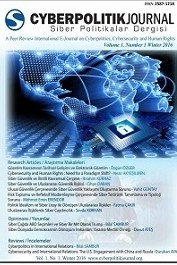THE CHANGING STRUCTURE OF WAR IN A CYBER-WORLD AND ITS IMPACT ON THE INTERNATIONAL HUMANITARIAN LAW
THE CHANGING STRUCTURE OF WAR IN A CYBER-WORLD AND ITS IMPACT ON THE INTERNATIONAL HUMANITARIAN LAW
War as a social construct of dominating others to achieve ones interest at the expense of other
in a competitive global community is an enigma to resolve in the discourse of International
Humanitarian Law. Thus, the salience of the transformations of the structure of war in the
midst of the current transition of geopolitics from a unipolar world to a seemingly multi-polar
world reverberate the debate of international law within the domain of cyber technological
weapons, specifically, International Humanitarian Law. This has raised many questions in the
application of international humanitarian law in a world where electromagnet weapons, cyber
weapons and high-tech defensive system are developed to counter enemy attack. This paper
discuss the changing nature of war in a cyber-world bringing to bear its impact on the
International Humanitarian Law. The paper posits that with the fast changes in war strategy
and cyber oriented weaponry, an improved sophisticated and inclusive laws with a stronger
institutional backing must be developed considering the socio-cultural and technological ideas
of countries to increase the level of compliance.
Keywords:
International Humanitarian law (IHL), armed conflict, structure of war, law of war. Cyberspace, Cyber technology Cyber weapons,
___
- Braden R. Allenby. “Are new technologies undermining the laws of war?” Bulletin of the Atomic Scientists, Vol. 70(1) 21–31. 2014. Collin Wills., Unmanned Combat Air system in the Future Warfare Gaining Control of the Air. 2015. Palgrave, Macmillan UK, England. Dietrich, Schindler, and Toman, Jiri., The Laws of Armed Conflict, 3 rd. ed., Martinus Nijhoff Publishers, The Netherlands, (1988). p.VII DUNANT Henry, A Memory of Solferino, ICRC, Geneva, 1986, p, 147 http://www.icrc.org http://papers.ssrn.com/sol3/papers.cfm?abstract_id=2359949. http://researcharchive.vuw.ac.nz/xmlui/bitstream/handle/10063/4414/thesis.pdf?sequence=2 https://www.icrc.org/eng/assets/files/publications/icrc-0739-part-i.pdf. https://www.loc.gov/rr/frd/Military_Law/pdf/law-war-handbook-2005.pdf. https://www.loc.gov/rr/frd/Military_Law/pdf/law-war-handbook-2005.pdf Human Rights Watch Report “Losing Humanity: The Case against Killer Robots” (November 2012) Human Rights Watch Hun –Yan Liu “Categorization and legality of autonomous and remote weapon systems” ICRCR No 886 (Volume 12, 2012) 628. MBDA. www.mbda-systems.com/products. Michael N Schmitt “Autonomous weapon systems: A reply to critics” (2013) Harv Nat’l Sec J 2. Michael N Schmitt and Jeffrey S Thurner “Out of the Loop: Autonomous weapon Systems and the Law of Armed Conflict” (2012) 4 Harv Nat’l Sec J 213. Noel E Sharkey “The evitability of autonomous robot warfare” ICRCR No 886 (Volume, 2012) Noel E Sharkey “The evitability of autonomous robot warfare” ICRCR No 886 (Volume, 2012) 788. Philippus Jacobus Jooste “Autonomous Weapon Systems In International Humanitarian Law – Simply Just Another Weapon System”.2014. LAWS 533. Research paper William Boothy “Some legal challenges posed by remote attack” ICRCR No 886 (Volume 12, 2012) 579. William Boothy. Conflict Law: The Influence of New Weapons Technology, Human Rights and .Emerging Actors. 2014 TMC Asser press .Hague
- ISSN: 2587-1218
- Başlangıç: 2017
- Yayıncı: Cyberpolitik Journal
Sayıdaki Diğer Makaleler
SİBER UZAYIN GÜVENLİKLEŞTİRİLMESİ: ABD ÖRNEĞİ
CYBER DETERRENCE BY PUNISHMENT: ROLE OF DIFFERENT PERCEPTIONS
Nasser S. ALAZWANİ, Thomas M CHEN
Cyber Security in Africa: The Threats and Challenges!
THINKING ON THE CHANGING REPRESENTATION OF MUSIC ON CYBERSPACE
Güncel Siber Güvenlik Tehditleri: Fidye Yazılımlar
SİBER ÇATIŞMALARIN TANIMLAMA SORUNU
THE IMPLICATIONS OF THE LACK OF A CYBER-CONFLICT DEFINITION
Siber Dünyanın Riskleri, Kişilerin ve Devletlerin Alabileceği Önlemler
